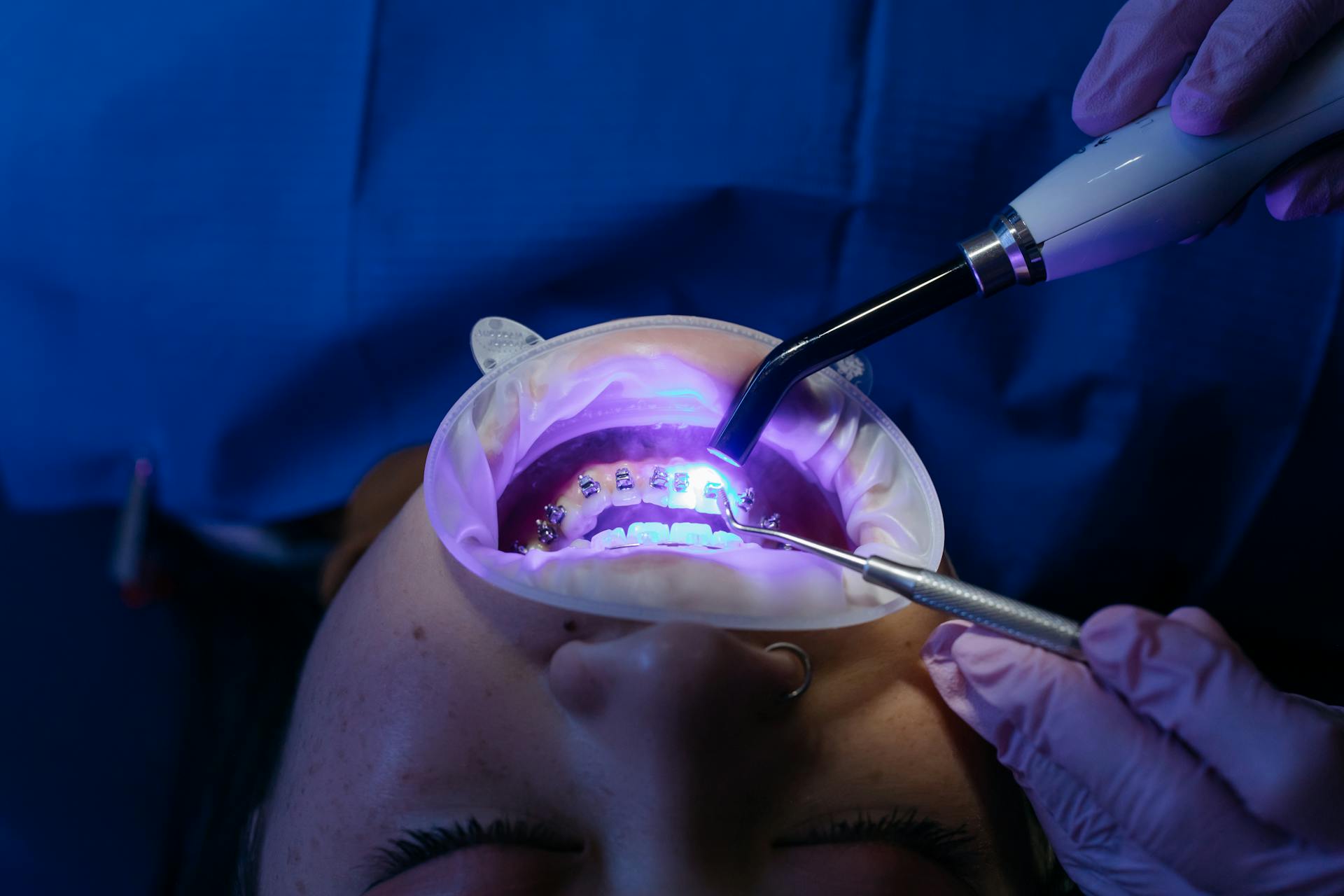
Comprehensive dental insurance is a type of insurance that covers a wide range of dental services, from routine cleanings and fillings to more complex procedures like crowns and root canals.
It typically includes a combination of preventive, basic, and major services, ensuring you're protected against unexpected dental expenses.
Preventive services, such as regular check-ups and cleanings, are usually covered at 100% or a low copayment.
Basic services, like fillings and extractions, are often covered at 50-80% of the cost, with you paying the remaining balance.
What Comprehensive Dental Insurance Covers
Comprehensive dental insurance covers a wide range of services to help maintain good oral health and address any dental issues that may arise.
Preventive care is a key aspect of comprehensive dental insurance, which may include regular dental cleanings, routine x-rays, and fluoride treatments.
Basic restorative care is also covered, such as fillings and tooth extractions.
Major restorative care, including root canals, bridges, crowns, and dentures, is also typically covered.
Orthodontic treatment, such as braces and other devices designed to align your teeth, is often included in comprehensive dental insurance plans.
Here's a breakdown of what comprehensive dental insurance may cover:
- Preventive care: regular dental cleanings, routine x-rays, and fluoride treatments
- Basic restorative care: fillings and tooth extractions
- Major restorative care: root canals, bridges, crowns, and dentures
- Orthodontic treatment: braces and other devices designed to align your teeth
Comprehensive vs Basic
Comprehensive dental insurance plans provide full coverage for a wide range of services, including preventive, basic, and major restorative care.
A full coverage dental insurance plan may provide for preventive dental care, such as regular dental cleanings, routine x-rays, and fluoride treatments.
Basic dental insurance plans, on the other hand, may only cover a few types of care, such as preventive and basic dental services, and can be a great choice if you get a portion of your dental coverage through other programs.
These narrower options can be more affordable with lower monthly premiums, but if you don't have partial dental coverage through another plan, a comprehensive dental insurance plan will help mitigate costs of care in ways a less extensive plan won't.
Check this out: Is Comprehensive Insurance the Same as Full Coverage
Here's a comparison of the two:
If you're unsure which type of plan is right for you, consider your individual needs, such as your dental history, current dental health, and potential future needs.
It's essential to evaluate these factors before making a decision, as they can help you determine the level of coverage that is appropriate for your circumstances.
Full Plan Cover
Full plan cover is a comprehensive dental insurance plan that provides coverage for a wide range of dental services. It's a great option if you want to ensure you and your family are taken care of no matter what happens.
A full coverage dental insurance plan may provide for preventive dental care, such as regular dental cleanings, routine x-rays, and fluoride treatments. It also covers basic restorative care, including fillings and tooth extractions, as well as major restorative care like root canals, bridges, crowns, and dentures.
If you have a pre-existing condition, such as missing teeth, you may be required to pay for treatment costs out-of-pocket. Some policies also don't cover cosmetic procedures, like teeth whitening, or select procedures, such as orthodontia.
Expand your knowledge: Full Cover Health Insurance
Here are some key services that a full coverage dental insurance plan typically covers:
- Preventive dental care
- Basic restorative care
- Major restorative care
- Orthodontic treatment
It's also worth noting that some full coverage plans may have waiting periods or limitations on coverage for certain procedures. It's essential to review the plan details carefully to ensure it meets your needs.
Cost and Affordability
The cost of comprehensive dental insurance can be a significant factor in your decision-making process. The average monthly premium cost for a comprehensive dental plan in the US is around $52 for an individual.
However, this price can vary depending on your insurance provider and the plan's offerings. Your plan's yearly maximum and out-of-pocket costs, such as your deductible, copays, and coinsurance, can also affect your premium amount.
Here are some key factors to consider when evaluating the cost of your dental insurance plan:
- Annual maximum: The highest amount your plan will pay for services within the calendar year.
- Deductible: The amount you must pay out of pocket for care before your plan begins covering costs.
- Coinsurance: A fixed percent of your dental bill that you pay for services.
These factors can contribute to your out-of-pocket insurance costs, so it's essential to make note of them when choosing a plan that aligns with your budget.
Lower Out-of-Pocket Expenses
The average monthly premium cost for a comprehensive dental plan in the US is around $52 for an individual, but this price depends on your insurance provider and plan.
Having a deductible, copays, and coinsurance can affect your premium amount. The annual maximum is the highest amount your plan will pay for services within the calendar year, after which you begin paying for care out of pocket.
A managed-care dental plan can offer lower out-of-pocket expenses by negotiating lower fees with participating dentists.
Making note of factors like your dental insurance carrier and plan, the type of care you need, and your family's ages can help you determine the dental insurance plan that aligns best with your budget.
Here are some key factors to consider when choosing a plan:
- Annual maximum: The highest amount your plan will pay for services within the calendar year.
- Deductible: The amount you must pay out of pocket for care before your plan begins covering costs.
- Coinsurance: A fixed percent of your dental bill that you pay for services.
By choosing a plan with a managed-care dental plan and lower out-of-pocket expenses, you can benefit from streamlined paperwork, a network of in-network providers, and a focus on preventive care, leading to more accessible and cost-effective dental treatments.
Indemnity
Indemnity plans offer a broader selection of dental-care providers than managed-care plans. This is because they don't have a network of preferred providers.
You'll need to pay all the costs upfront and then bill your insurance company, which will reimburse you for covered charges.
Types of Plans and Coverage
Comprehensive dental insurance plans cover a wide range of services, including preventive care, basic restorative care, major restorative care, and orthodontic treatment. They can also provide coverage for select procedures, but may not cover pre-existing conditions or cosmetic procedures.
You can choose from different types of plans, including comprehensive plans and more basic options. Comprehensive plans typically cover a broader range of services, while narrower plans may only cover preventive and basic dental services. These narrower options can be a great choice if you get a portion of your dental coverage through other programs.
Here's a summary of the main differences between comprehensive and narrower plans:
Keep in mind that these are just some of the key differences, and you should review the plan details carefully to ensure it meets your needs.
Primary vs. Supplemental
Primary vs. Supplemental Dental Insurance: What's the Difference?
Primary dental insurance is a standard plan that covers routine dental care, such as checkups, X-rays, and cleanings. It's often provided by employers as part of their benefits package.
Supplemental dental insurance, on the other hand, offers additional coverage beyond what's provided by primary insurance. It can fill in the gaps in coverage and provide benefits for more extensive or specialized dental treatments.
Here are some key differences between primary and supplemental dental insurance:
For example, if you have a primary plan that covers only part of your expenses, a supplemental plan can help cover some or all of your costs. Supplemental dental insurance tends to provide a given amount of coverage for certain types of procedures and care, just as primary plans do.
Related reading: Primary Dental Insurance
In some cases, individuals and families with limited dental coverage from their primary insurance can benefit from supplemental dental insurance. This audience often faces restrictions in their primary plan, such as waiting periods for certain treatments or limited coverage for specialized procedures. Supplemental dental insurance can fill these gaps and offer additional coverage for services like orthodontics, dental implants, and cosmetic dentistry.
Managed Care
Managed care plans require you to use a dental provider network.
Dentists in a network agree to perform services at pre-negotiated rates and submit claims to the insurance company for you.
Managed care plans come in two varieties: health maintenance organization plans (HMOs) and preferred provider organization plans (PPOs).
Expand your knowledge: The Four Types of Managed Health Care Plans Are:
Choosing and Understanding a Plan
Choosing a comprehensive dental insurance plan can be overwhelming, but it's essential to consider a few key factors. You'll want to choose a plan that fits your lifestyle and ensures you're seeing a dentist regularly.
First, consider the limitations of each plan. Does your plan require a waiting period? This could prolong the time you must wait to get a procedure done after purchasing coverage. For example, if you need a crown on dentures, a waiting period could be a significant issue.
Next, think about the dentists you'll be able to see. Some plans may not provide coverage for particular dentists, so it's crucial to research this beforehand. You may also want to consider whether the plan is available in your area, as not all plans are available everywhere.
Understanding the different types of dental insurance plans can also help you make an informed decision. Typically, dental insurance policies fall into three primary categories: preventive, basic, and major plans. Here are some key characteristics of each:
To choose the right plan, consider your individual needs, including your dental history, current health, and potential future needs. You should also compare network providers and analyze costs and benefits. Finally, review any waiting periods or exclusions within the policy to ensure you understand what's covered and what's not.
Frequently Asked Questions
Which dental insurance has the best coverage?
Delta offers the best dental insurance coverage, providing the most plans with adult braces coverage and the highest lifetime coverage.
Sources
- https://www.healthpartners.com/blog/comprehensive-full-coverage-dental-insurance/
- https://www.deltadental.com/us/en/protect-my-smile/dental-insurance-101/full-coverage-dental-insurance.html
- https://www.ehealthinsurance.com/resources/dental-insurance/comprehensive-guide-supplemental-dental-insurance
- https://hushp.harvard.edu/your-benefits/optional-dental-plans-benefits/
- https://www.medi-solutions.org/blog/a-comprehensive-guide-to-dental-insurance-protect-your-smile-and-overall-health
Featured Images: pexels.com


